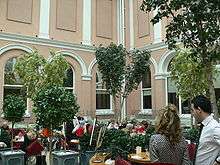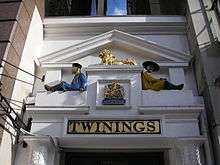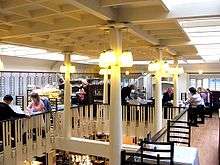Tearoom (UK and US)

A tearoom or tea shop is a small restaurant where beverages and light meals are served, usually having a sedate or subdued atmosphere. Establishments like this in various countries around the world can be grouped together as teahouses. This article deals with tea in the United Kingdom, and to a lesser extent, other English-speaking countries.
Other meanings and related words

A distinction needs to be made between two related meanings of "tea shop": a retail shop, and a place to eat and drink. Dry tea (first, loose tea leaves, and then in teabags) used to be sold at grocers' shops, and now mainly at supermarkets. One of the oldest shops that still specialises in selling tea for consumption at home is Twinings, which has been operating from the same premises in central London since it opened in 1706. The second meaning of tea shop, or more commonly tea room, as a commercial establishment selling hot drinks, and possibly something to eat, is the main subject of this article.
In a related usage, a tea room may be a room set aside in a workplace for employees to relax and specifically to take refreshment during work-breaks. Traditionally, a staff member serving hot drinks and snacks at a factory or office was called a tea lady, although this position is now almost defunct. In addition, in American English, "tearoom" is gay slang for a public toilet where men have sex (see cottaging).
Tea is a prominent feature of British culture and society.[1] Britain has for centuries been one of the world's greatest tea consumers, and now consumes an average per capita tea supply of 1.9 kg (4.18 lbs) per year.[2]
The first appearance of tea in England
Shortly before the Restoration of 1660, Chinese green tea was introduced to the coffeehouses of London,[3] which were significant places of social interaction, distinct from pubs, taverns, and inns. The owner of the coffeehouse explained the new beverage in a pamphlet: "That Excellent, and by all Physicians approved, China drink, called by the Chinese, Tcha, by other nations Tay alias Tee, ...sold at the Sultaness-head, ye Cophee-house in Sweetings-Rents, by the Royal Exchange, London". [4] "Coffee, chocolate and a kind of drink called tee" were "sold in almost every street [in London] in 1659", according to Thomas Rugge's Diurnall.[5] Tea was mainly consumed by upper and mercantile classes: Samuel Pepys, curious for every novelty, tasted the new drink in 1660 and recorded the experience in his diary for 25 September: "I did send for a cup of tee, (a China drink) of which I had never had drunk before".[6]
Victorian Britain

Hogarth's Gin Lane was not the first warning about working class drunkenness. One response to the perception of widespread dissolution was the temperance movement, which promoted tea as a healthful alternative to alcohol of any sort. From the 1830s many new cafes and coffeehouses opened, as a place to socialise that was not a pub or an inn. Tearooms were also significant since they provided a place where women in the Victorian era could take a meal — without a male escort — without risk to their reputations. Tea rooms catered for all classes of society.
In 1864, the Aerated Bread Company opened the first of what would grow to be known as A.B.C. Tea Shops. The idea came from a London-based "manageress" at ABC "who'd been serving gratis tea and snacks to customers of all classes, [and] got permission to put a commercial public tearoom on the premises."[7] By 1923, the A.B.C. tea shops had 250 branches,[8] second only to J. Lyons and Co.. Lyons Corner Houses started in 1894, and soon became the leading chain of tea rooms; their waitresses were known as "nippies" for the speed of their work.
In 1878 Catherine Cranston opened the first of what became a chain of Miss Cranston's Tea Rooms in Glasgow, Scotland, providing elegant well-designed social venues which for the first time provided for well-to-do women socialising without male company. They proved widely popular. She engaged up and coming designers, becoming a patron of Charles Rennie Mackintosh. He designed the complete building of the Willow Tearooms, a strikingly modern exterior as well as a series of interesting interior designs. Similar establishments became popular throughout Scotland. As of 2016, the Glasgow Willow Tearooms are being restored.
Roger Fulford argues that tea rooms benefitted women, in that these neutral public spaces were instrumental in the "spread of independence" for women and their struggle for the vote.[9] Paul Chrystal characterises tea rooms as "popular and fashionable, especially with women", providing the a dignified and safe place to meet and eat, and strategise on political campaigns.[10]
Hotels and the contemporary tea room

There is a long tradition of tea rooms within London's hotels. For example, Brown's Hotel has been serving tea for over 170 years [11] From the 1880s fine hotels in both the US and the UK featured tea rooms and tea courts, and by 1910 they had begun to host afternoon tea dances as dance crazes swept both countries.
Tea rooms of all kinds were widespread in Britain by the 1950s, but in the following decades cafés became more fashionable, and tea rooms became less common. Nonetheless, there are still plenty of places that offer the opportunity to enjoy afternoon tea, a luxurious light meal of savoury snacks (tea sandwiches) and small pastries. A less formal alternative is a cream tea, particularly popular in the West Country: a scone with jam and clotted cream. Another possibility is the high tea, hot savoury food as the day's final (but relatively early) meal. There are plenty of regional variations: in Scotland, teas are usually served with a scones, pancakes, crumpets and other cakes.
Tea rooms can be found in most towns and many villages.
Other notable examples
- teany, Tea NY, closed 2015
- The Tea Room, run by Queen's University in Canada
References
- ↑ "A very British beverage: Why us Brits just love a cuppa". Express. 23 September 2016.
- ↑ "Food Balance Sheets". Food and Agriculture Organisation of the United Nations.
- ↑ Mair, Victor H.; Hoh, Erling (2009). The True History of Tea. Thames & Hudson. p. 169. ISBN 978-0-500-25146-1.
- ↑ Niall Ferguson, Empire: the rise and demise of the British world order, (2004:11).
- ↑ Rugge's Diurnall is preserved in the British Library (Add. MSS. 10,116-117); it was published as The diurnal of Thomas Rugg, 1659-1661, William Lewis Sachse ed., (1961)
- ↑ Richard, Lord Braybrooke, ed., note in The Diary and Correspondence of Samuel Pepys, F.R.S., vol. I :109.
- ↑ Brandt, Pamela Robin. “Tea for View, View for Tea,” Miami New Times. October 17, 2002. (Retrieved 2009-05-08). See also: “英格兰饮茶风俗由何而来? (二),” British Council China. August 8, 2007. (Retrieved 2009-05-08).
- ↑ "Aerated Bread Company (ABC)", London Metropolitan Archives. National Archives. ACC/2910, 1869-1885. (Retrieved 2009-05-08).
- ↑ Votes for Women 1957, quoted in Tea: A Very British Beverage by Paul Chrystal 2014.
- ↑ Chrystal, Paul (2014). Tea: A Very British Beverage.
- ↑ "Luxury Hotels - 5 Star Hotels and Resorts - Rocco Forte". Browns Hotel.
| Look up tea room in Wiktionary, the free dictionary. |
Further reading
- Brigid Keane, Olive Portnoy (1992). "English Tearoom". In Harlan Walker. Oxford Symposium on Food and Cookery 1991: Public Eating; Proceedings. Prospect Books. ISBN 978-0-907325-47-5.
| Wikimedia Commons has media related to Tea rooms. |